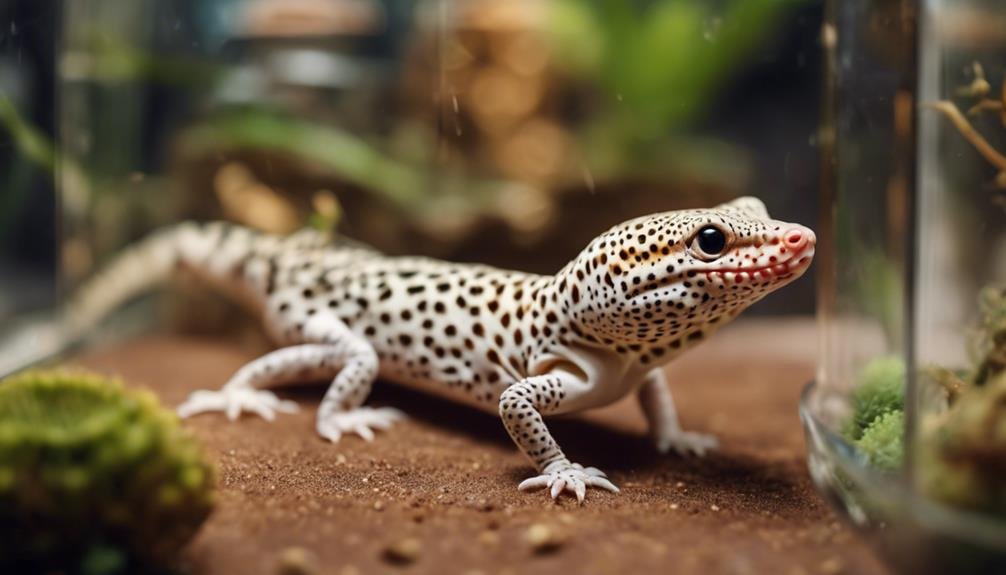If you’ve recently noticed your leopard gecko starting to shed its skin more frequently, or perhaps less often than expected, you might be wondering if this is cause for concern. Shedding is a natural and essential process for these creatures, helping them maintain healthy skin as they grow. However, variations in shedding frequency can indeed signal underlying health issues that shouldn’t be overlooked. Before you start worrying, it’s important to understand the typical shedding patterns of leopard geckos and how to recognize when something might be amiss. Join the conversation to uncover the nuances of leopard gecko shedding and learn when you should take action.
Key Takeaways
- Leopard geckos shed every 2-4 weeks, with juveniles shedding more frequently than adults.
- Regular shedding is crucial for their growth and health, indicating good health.
- A change in shedding frequency or difficulty can signal health issues or improper habitat conditions.
- Providing a moist hide and maintaining ideal humidity levels can support healthy shedding.
- If shedding issues persist, seeking veterinary care is recommended to address potential health concerns.
Understanding Leopard Gecko Shedding
To truly grasp why your leopard gecko sheds its skin, it’s essential to understand that this process is important for its growth and overall health. Leopard gecko shedding is a natural and significant aspect of their life cycle, allowing them to remove old skin and make way for new, healthier skin. This isn’t just about appearance; it’s a sign of good health. Young geckos will shed more often, every 2-4 weeks, as they grow at a faster rate compared to adults.
Proper shedding is seamless and usually wraps up within a few hours, with the gecko shedding its skin in one piece. This indicates that your pet is healthy and not suffering from nutritional deficiencies that can lead to issues like metabolic bone disease—a condition you want to avoid at all costs.
Ensuring your leopard gecko has a moist hide available in its enclosure is crucial. This special area aids the shedding process, making it easier for the gecko to slough off its old skin. Monitoring your gecko’s shedding pattern is more than just an observation; it’s a key health indicator.
Recognizing Shedding Signs
You can spot the early signs of shedding in your leopard gecko by noticing a duller coloration and a retreat to their moist hide more often than usual.
After they’ve shed, you might observe changes in their behavior, such as increased activity or a return to regular eating patterns.
Paying attention to these clues will help you guarantee they’re healthy and shedding properly.
Identifying Early Shedding Signs
Recognizing early shedding signs in your leopard gecko is key to ensuring they have a smooth and stress-free shedding process.
When a leopard gecko shed is imminent, you’ll notice their skin turning a dull, grayish-white color. This is especially true for a juvenile leopard gecko, who may shed more frequently due to rapid growth.
Watch for behavioral changes such as spending more time in moist hiding spots and showing less interest in food. These signs suggest your gecko is preparing for a shed.
They might also start rubbing against rocks to loosen the old skin, beginning from the head.
Spotting these signs early can help you prevent potential shedding problems by making sure their environment is suitable for this natural process.
Post-Shedding Behavior Changes
After your leopard gecko has shed, you might notice they’re more active and seem to explore their environment with renewed vigor. This burst of energy and curiosity is one of the post-shedding behavior changes you’ll observe.
It’s not just about getting rid of old skin; it’s as if they’re embracing their new skin with excitement. You’ll see their colors more vibrant and their appetite might increase, showing they’re feeling excellent. They could also be basking more, soaking up the warmth to help their new skin adjust perfectly.
These shifts, from hunting with more enthusiasm to spending extra time under heat sources, indicate a healthy transformation post-shedding. So, when you spot your geckos shedding and then witness these remarkable behavior changes, know it’s all part of their natural cycle.
Ideal Shedding Frequency
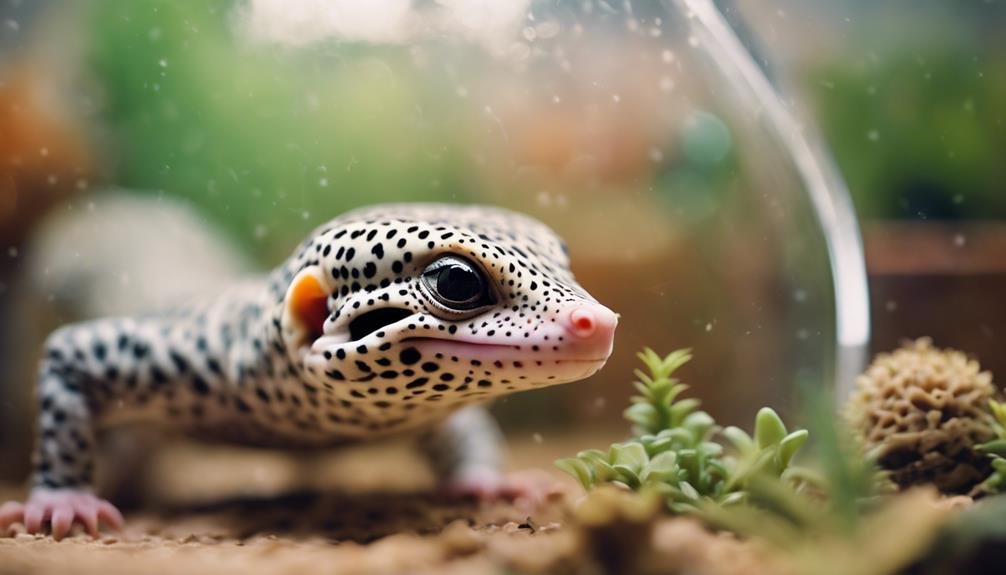

Understanding the ideal shedding frequency for your leopard gecko is essential for ensuring their health and well-being. Leopard geckos, fascinating creatures that they are, have specific needs when it comes to shedding, closely linked to their growth rate and health maintenance. For juvenile leopard geckos experiencing rapid growth, shedding every 2-3 weeks is typical. This frequent shedding supports their development, allowing them to grow out of their old skin and into their new, larger bodies efficiently.
As leopard geckos reach maturity, their shedding frequency decreases, usually settling at about once a month. This change reflects their slower growth rate and the stabilization of their physical size. However, it’s important to remember that:
- Shedding intervals can vary among individual geckos based on age, diet, and environmental conditions.
- Regular shedding is essential for maintaining healthy skin and overall well-being.
- Monitoring shedding frequency can offer insights into your gecko’s health and indicate if there might be underlying issues.
Seasonal Shedding Patterns
While many animals adjust their shedding to align with the seasons, leopard geckos shed their skin throughout the year, regardless of the season. This important aspect of leopard gecko care means you’ll need to be vigilant about your pet’s shedding habits year-round. Unlike other reptiles that might have a shedding season, your leopard gecko’s need to shed skin isn’t dictated by the weather outside but by their own growth and health.
Understanding your leopard gecko’s individual shedding cycle is vital. Young geckos often shed more frequently, sometimes every 2-3 weeks, as they grow. In contrast, adult geckos might only shed once a month. This variance makes it essential to keep a close eye on your pet, as abnormal shedding could signal health issues.
| Age Group | Typical Shedding Frequency |
|---|---|
| Young Geckos | Every 2-3 weeks |
| Adult Geckos | Monthly |
If you notice your leopard gecko isn’t shedding as expected, it could be a sign of abnormal shedding. This deviation from their normal pattern warrants further investigation, as it might indicate an underlying health concern. Being aware of these details helps you provide the best care for your leopard gecko, ensuring they remain healthy and happy.
Shedding Duration Insights
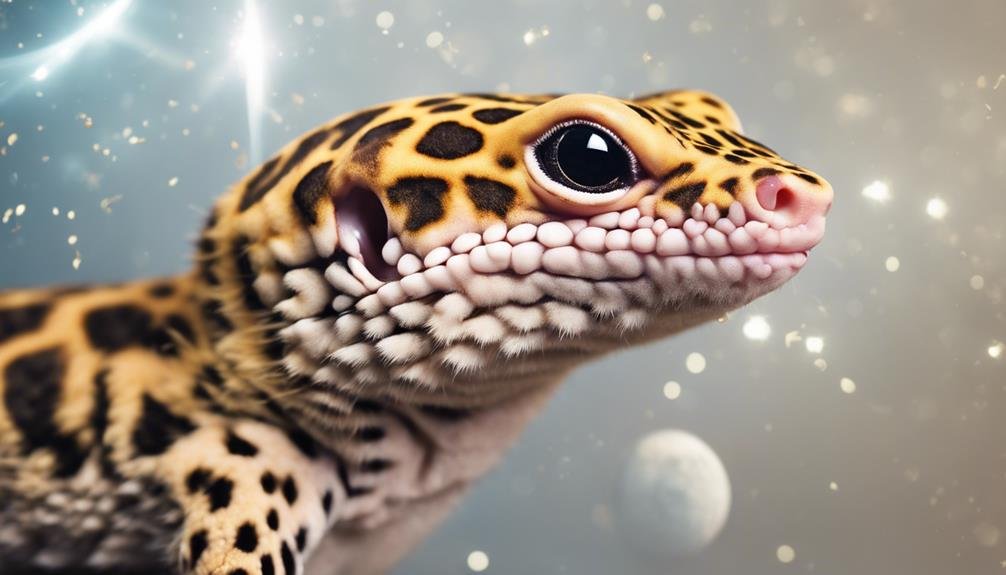

Leopard geckos typically complete their shedding process within 1-3 days, a period that can vary based on several factors including age and environmental conditions. While it might seem like a quick event, the actual shedding duration can range from as short as 10 minutes to as long as a full day. This variation is perfectly normal and part of the natural cycle of your pet’s life. Knowing what to expect can help you understand and support your leopard gecko through this process.
- Behavioral Changes: You might notice your gecko spending more time in its moist hide or showing signs of irritability. This indicates that the shedding is imminent.
- Influencing Factors: The age and health of your leopard gecko, coupled with the humidity and temperature of their environment, play essential roles in determining the shedding duration.
- Observation is Key: Watching your leopard gecko’s shedding behavior without interfering allows you to make sure everything is proceeding as it should, and they’re not experiencing any difficulties.
Understanding the shedding process, including the typical shedding duration, is important for any leopard gecko owner. It’s a natural behavior that, while it might require some adjustments in care, shouldn’t cause you undue worry.
Handling During Shedding
As you navigate your leopard gecko’s shedding period, it’s important to understand when and how to handle them gently to avoid stress and injury.
We’ll explore gentle handling tips and shedding support care to make sure your gecko’s skin renews smoothly.
Gentle Handling Tips
To minimize stress and potential harm, it’s best to avoid handling your leopard gecko during its shedding phase. During this sensitive period, Leopard Geckos need a stress-free environment to shed their skin properly. The process of shedding is vital and important for their health, but it can be stressful and uncomfortable for them. By providing gentle handling and making sure they’re not disturbed, you help maintain a calm atmosphere that supports their well-being.
- Wait until shedding is complete before gently interacting with your gecko to prevent skin damage.
- Create a comfortable habitat that facilitates a smooth shedding process without the need for intervention.
- Monitor their progress from a distance to make sure they’re shedding properly without directly handling them.
Shedding Support Care
Ensuring your gecko’s comfort during their shedding phase requires a hands-off approach to avoid stress and skin issues. When your leopard gecko is shedding, it’s important to minimize handling. This gentle and minimal interaction allows the shedding process to occur naturally. Handling your gecko during this time can disrupt the process, potentially leading to incomplete shedding or stuck shed, which are harmful to their health.
Instead, provide a quiet and calm environment that supports your gecko’s natural shedding process. Wait until the shedding is fully complete before resuming regular handling. This patience ensures your gecko’s well-being and helps maintain their skin in good condition, making the post-shedding handling a more pleasant experience for both you and your leopard gecko.
Feeding Amidst Shedding
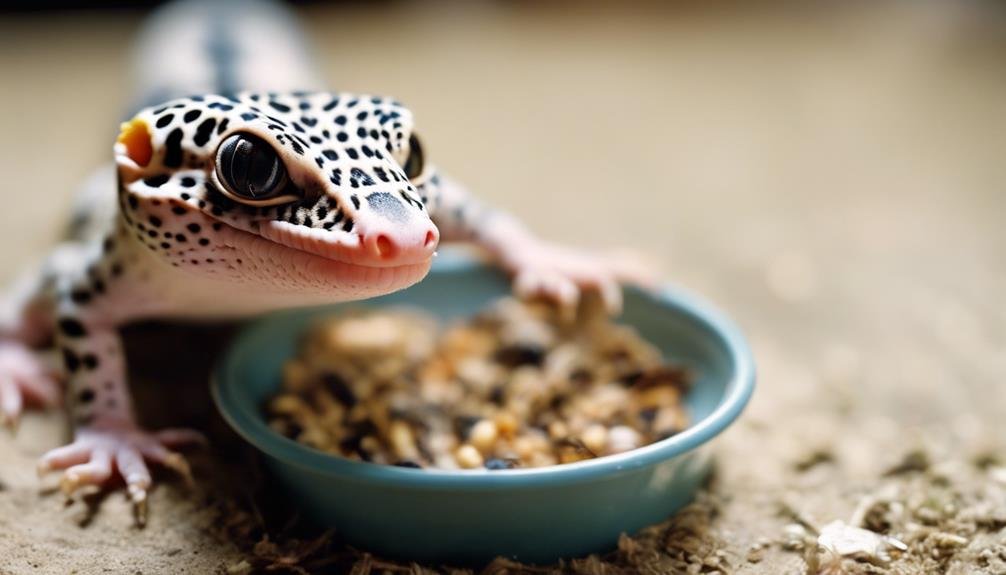

During shedding, leopard geckos may show less interest in eating, but it’s still important to feed them if they’re willing to eat. As a gecko owner, you’ll notice when your pet starts to shed their skin, their appetite might decrease. This is a normal behavior, so there’s no need to worry. However, making sure they continue to get the nutrition they need is essential. Here are a few tips to make feeding during this time easier and more effective:
- Offer smaller or softer prey items: Mealworms or wax worms are great options as they’re easier to digest and less stressful for your gecko to eat.
- Keep the feeding area clean: A clean environment reduces stress, making it more likely for your gecko to eat.
- Monitor your gecko’s weight: Adjust feeding frequency and quantity to ensure your gecko maintains a healthy weight during and after shedding.
Feeding your leopard gecko during shedding doesn’t have to be a challenge. With a little patience and attention to their needs, you can help them stay healthy and comfortable as they shed their skin. Remember, a moist environment can aid the shedding process, but we’ll save that topic for another time.
Addressing Shedding Issues
While most leopard geckos shed without issues, some may encounter problems requiring your attention. Shedding frequency, varying every 2-4 weeks, is a natural process for growth and renewal. However, stuck shed, particularly on delicate areas like eyelids and toes, can lead to severe health complications. Environmental factors, including improper humidity levels, often contribute to these shedding issues.
Maintaining adequate humidity is paramount for a successful shed. A shallow dish of water in the enclosure can help keep the environment moist, supporting the shedding process. For leopard geckos under a few months old, paying extra attention to humidity and hydration is essential, as their young skin is more prone to shedding problems.
If you notice stuck shed, it’s important not to force it off, as this could harm your gecko. Instead, gently increase enclosure humidity or consider a moist hide. Persistent shedding problems, despite these efforts, warrant professional veterinary care. Seeking help early can prevent the situation from escalating into more serious health issues. Remember, while shedding is a natural occurrence, your vigilance can make sure it remains a stress-free process for your leopard gecko.
Enhancing Shedding Health
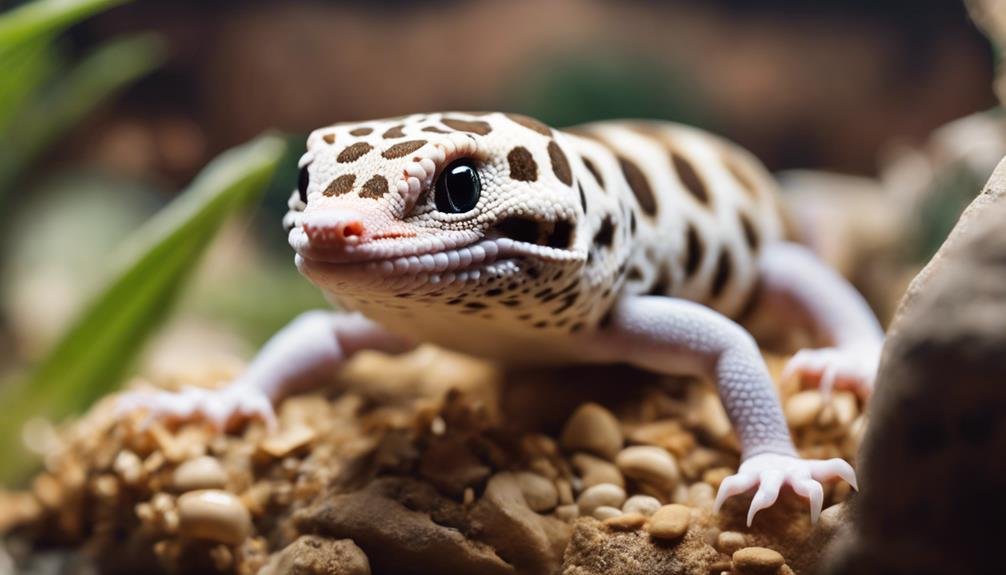

To enhance your leopard gecko’s shedding health, consider providing a moist hide with the appropriate substrate. This step is vital in creating an environment that mimics their natural habitat, promoting a smoother shedding process. By paying attention to the specific needs of your pet, you can prevent common issues like stuck sheds, which can lead to discomfort or even health problems if not addressed.
Here are a few key measures you can take to ensure the healthiest shedding experience for your leopard gecko:
- Maintain ideal humidity levels within the enclosure to support the shedding process. A hygrometer can help you monitor these levels accurately.
- Offer a rough surface, such as reptile carpet or clean rocks, for your gecko to rub against. This aids in the removal of old skin, especially in hard-to-reach areas.
- Avoid oil-based treatments for any stuck sheds, particularly around sensitive areas like the toes or eyes. Instead, consult a veterinarian for safe removal methods.
Regularly monitoring your leopard gecko’s shedding behavior and seeking veterinary assistance for severe shedding issues are essential steps in ensuring their overall well-being. By following these guidelines, you’re providing your pet with the best care possible.
Is a Leopard Gecko’s Sleeping Pattern Related to Its Shedding Frequency?
A leopard gecko’s sleeping patterns are closely linked to its shedding frequency. During periods of shedding, leopard geckos may appear less active and spend more time sleeping as their bodies work to remove old skin. Understanding these natural behaviors can help leopard gecko owners provide the best care for their pets.
Frequently Asked Questions
Why Have I Never Seen My Gecko Shed?
You’ve likely never seen your gecko shed because they’re quick at shedding their skin, often doing it in privacy and under the cover of night. Leopard geckos are nocturnal, preferring to shed away from prying eyes, and they might even eat their shed skin, leaving no trace behind.
How Do I Know When My Leopard Gecko Is About to Shed?
You’ll notice your leopard gecko is about to shed when its skin starts whitening, showing a dull, grayish hue. Keep an eye out for behavior changes, like spending more time in their moist hide and showing less activity. Eye cloudiness is a clear sign shedding is near.
Also, if their appetite decreases, it’s likely due to the upcoming shed. These signs are normal, so there’s no need to worry!
How Often Should You Take Your Leopard Gecko Out?
You should limit handling your leopard gecko to avoid stress, aiming for minimal interaction to not disrupt their environment. Watch for stress signs when you do interact, and make sure their space has plenty of environmental enrichment to keep them engaged without needing frequent social interactions.
Handling frequency should be low, especially during sensitive times like shedding. Prioritize their well-being over the desire for frequent handling to guarantee a happy, healthy gecko.
Should I Mist My Leopard Gecko?
Yes, you should mist your leopard gecko’s enclosure. Misting helps maintain the right humidity levels, important for your gecko’s skin health. Aim for humidity levels between 20-40% in their tank setup. Use a hygrometer to keep track.
A proper misting schedule guarantees their environment isn’t too dry, aiding in shedding and overall well-being. However, avoid overdoing it to prevent excess moisture, which can be harmful. Remember, a moist hide is also essential for their shedding process.
Conclusion
To sum up, your leopard gecko’s shedding is a natural, essential process for their health. You should expect juveniles to shed every 2-3 weeks and adults about once a month.
Keep an eye out for any irregularities, like stuck shed or too frequent shedding, as these could signal health issues. Don’t hesitate to consult a vet if you’re concerned.
Remember, proper care, including a good diet and habitat, can greatly enhance their shedding health. Stay attentive and supportive during these times.

